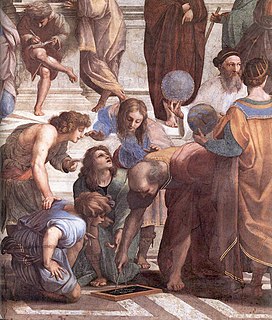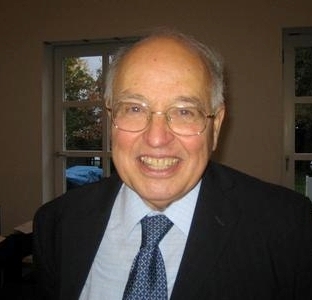Brouwer's fixed-point theorem is a fixed-point theorem in topology, named after L. E. J. (Bertus) Brouwer. It states that for any continuous function mapping a compact convex set to itself there is a point such that . The simplest forms of Brouwer's theorem are for continuous functions from a closed interval in the real numbers to itself or from a closed disk to itself. A more general form than the latter is for continuous functions from a convex compact subset of Euclidean space to itself.

In mathematics, a conjecture is a conclusion or proposition based on incomplete information, for which no proof or disproof has yet been found. Conjectures such as the Riemann hypothesis or Fermat's Last Theorem have shaped much of mathematical history as new areas of mathematics are developed in order to prove them.

Differential geometry is a mathematical discipline that uses the techniques of differential calculus, integral calculus, linear algebra and multilinear algebra to study problems in geometry. The theory of plane and space curves and surfaces in the three-dimensional Euclidean space formed the basis for development of differential geometry during the 18th century and the 19th century.

Euclidean geometry is a mathematical system attributed to Alexandrian Greek mathematician Euclid, which he described in his textbook on geometry: the Elements. Euclid's method consists in assuming a small set of intuitively appealing axioms, and deducing many other propositions (theorems) from these. Although many of Euclid's results had been stated by earlier mathematicians, Euclid was the first to show how these propositions could fit into a comprehensive deductive and logical system. The Elements begins with plane geometry, still taught in secondary school as the first axiomatic system and the first examples of formal proof. It goes on to the solid geometry of three dimensions. Much of the Elements states results of what are now called algebra and number theory, explained in geometrical language.

Sir Michael Francis Atiyah was a British-Lebanese mathematician specialising in geometry.
In mathematics, the Poincaré conjecture is a theorem about the characterization of the 3-sphere, which is the hypersphere that bounds the unit ball in four-dimensional space. The conjecture states:
Every simply connected, closed 3-manifold is homeomorphic to the 3-sphere.
In mathematics, Thurston's geometrization conjecture states that each of certain three-dimensional topological spaces has a unique geometric structure that can be associated with it. It is an analogue of the uniformization theorem for two-dimensional surfaces, which states that every simply connected Riemann surface can be given one of three geometries . In three dimensions, it is not always possible to assign a single geometry to a whole topological space. Instead, the geometrization conjecture states that every closed 3-manifold can be decomposed in a canonical way into pieces that each have one of eight types of geometric structure. The conjecture was proposed by William Thurston (1982), and implies several other conjectures, such as the Poincaré conjecture and Thurston's elliptization conjecture.

Grigori Yakovlevich Perelman is a Russian mathematician. He has made contributions to Riemannian geometry and geometric topology. In 1994, Perelman proved the soul conjecture. In 2003, he proved Thurston's geometrization conjecture. The proof was confirmed in 2006. This consequently solved in the affirmative the Poincaré conjecture.
In mathematics, the Weil conjectures were some highly influential proposals by André Weil (1949), which led to a successful multi-decade program to prove them, in which many leading researchers developed the framework of modern algebraic geometry and number theory.
Ergodic theory is a branch of mathematics that studies dynamical systems with an invariant measure and related problems. Its initial development was motivated by problems of statistical physics.
The Schauder fixed point theorem is an extension of the Brouwer fixed point theorem to topological vector spaces, which may be of infinite dimension. It asserts that if is a nonempty convex closed subset of a Hausdorff topological vector space and is a continuous mapping of into itself such that is contained in a compact subset of , then has a fixed point.
In mathematics, more specifically in abstract algebra, in the theory of Lie algebras, the Poincaré–Birkhoff–Witt theorem is a result giving an explicit description of the universal enveloping algebra of a Lie algebra. It is named after Henri Poincaré, Garrett Birkhoff, and Ernst Witt.
R. H. Bing was an American mathematician who worked mainly in the areas of geometric topology and continuum theory. His father was named Rupert Henry, but Bing's mother thought that "Rupert Henry" was too British for Texas. She compromised by abbreviating it to R. H. Consequently, R. H. does not stand for a first or middle name.
In mathematics, a fixed-point theorem is a result saying that a function F will have at least one fixed point, under some conditions on F that can be stated in general terms. Results of this kind are amongst the most generally useful in mathematics.

John Robert Stallings Jr. was a mathematician known for his seminal contributions to geometric group theory and 3-manifold topology. Stallings was a Professor Emeritus in the Department of Mathematics at the University of California at Berkeley where he had been a faculty member since 1967. He published over 50 papers, predominantly in the areas of geometric group theory and the topology of 3-manifolds. Stallings' most important contributions include a proof, in a 1960 paper, of the Poincaré Conjecture in dimensions greater than six and a proof, in a 1971 paper, of the Stallings theorem about ends of groups.
Foundations of geometry is the study of geometries as axiomatic systems. There are several sets of axioms which give rise to Euclidean geometry or to non-Euclidean geometries. These are fundamental to the study and of historical importance, but there are a great many modern geometries that are not Euclidean which can be studied from this viewpoint. The term axiomatic geometry can be applied to any geometry that is developed from an axiom system, but is often used to mean Euclidean geometry studied from this point of view. The completeness and independence of general axiomatic systems are important mathematical considerations, but there are also issues to do with the teaching of geometry which come into play.

George David Birkhoff was an American mathematician best known for what is now called the ergodic theorem. Birkhoff was one of the most important leaders in American mathematics in his generation, and during his time he was considered by many to be the preeminent American mathematician.










